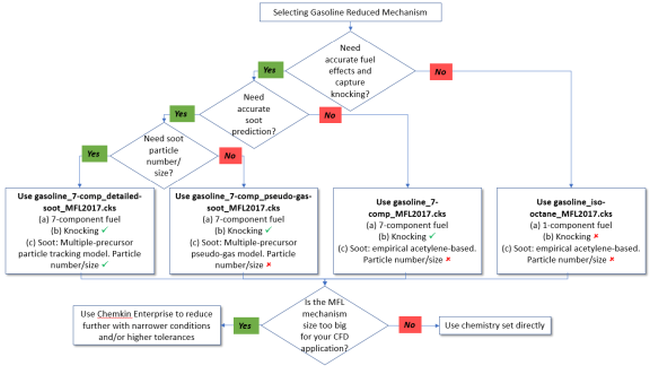Four gasoline reduced mechanisms are available. The flowchart shown in Figure 2.4: Decision flowchart for selecting MFL gasoline mechanism summarizes the applicability of the four mechanisms. More details of these four mechanisms are presented in the subsections below.
The gasoline_iso-octane_MFL2017.cks chemistry set represents gasoline with iso-octane (mechanism name: ic8h18) as the surrogate. The focus of this chemistry set is on modeling ignition, heat release, and emissions at high-temperatures in gasoline engines. For the emissions, the following species predictions are expected to be accurately predicted:
Soot-precursor species (two-step soot model only):
acetylene (c2h2)
CO (co)
NOx (no and no2)
Unburned hydrocarbons
With acetylene as the soot-precursor, this mechanism can be used with the two-step soot model.
The mechanism has been reduced for the following range of conditions:
Pressure: 1–100 bar
Temperature: 1200 K and above
Equivalence ratio: 0.4–3
EGR: 0–40%
This mechanism has been reduced from the full mechanism “Gasoline_PAH_NOx” in the MFL database, which has been thoroughly validated against fundamental experimental data for the operating conditions of interest for gasoline engines. The mechanism was reduced from this comprehensive full mechanism using the Reaction Workbench software, for the conditions listed above. The Model Fuel Library Validation Manual provides the mechanism validation plots.
The 7-component gasoline surrogate composition used is: 22.4 wt% iso-octane/30.4 wt% toluene/19.1 wt% n-pentane/11.2 wt% MCH/7.5 wt% 1-hexene/7.3 wt% 1,2,4-trimethyl benzene/2.1 wt% n-butane. There are three chemistry sets for this surrogate:
gasoline_7-comp_MFL2017.cks
gasoline_7-comp_pseudo-gas-soot_MFL2017.cks
gasoline_7-comp_detailed-soot_MFL2017.cks
The difference between the three chemistry sets is the soot model they can be used with; they are any acetylene-based empirical soot model, the pseudo-gas soot model, and the Method of Moments soot model, respectively. The same reduced chemistry set may be used for a surrogate whose composition is different, as long as it consists of the same fuel components (or a subset) and includes a similar amount of the fastest-burning component (in this case mainly n-pentane). The focus of this chemistry set is on modeling ignition, heat release, and emissions at low- to high-temperatures in gasoline engines, from HCCI to GDI conditions. The mechanism can be used to model knocking in gasoline engines. It can be used to track soot particle mass, number, and sizes in Ansys Chemkin and employs the Method of Moments in Ansys Forte. This chemistry can be used to predict CO, HC (hydrocarbons), and NOx emissions from gasoline engines.
For the composition used in the reduction, the surrogate has the following liquid-fuel properties:
| Aromatics, vol% | 37.7 |
| Research Octane Number | 95.9 |
| Motored Octane Number | 87 |
| Molar H/C ratio | 1.81 |
| Liq. Density, g/cm3 | 0.73 |
| Distillation curve | |
| T10, K | 340 |
| T30, K | 354 |
| T50, K | 368.5 |
| T70, K | 378.7 |
| T90, K | 392.7 |
The mechanism has been reduced for the following range of conditions:
Pressure: 1–100 bar
Temperature: 700–2000 K
Equivalence ratio: 0.4–3
EGR: 0–30%
This mechanism has been reduced from the full mechanism “Gasoline_PAH_NOx” in the MFL database, which has been thoroughly validated against fundamental experimental data for the operating conditions of interest for gasoline engines. The Model Fuel Library Validation Manual includes the mechanism validation plots. The mechanism was reduced from this comprehensive full mechanism using the Reaction Workbench software, for the conditions listed above.
For the emissions, the following species predictions are expected to be accurately predicted:
Soot-precursor species:
acetylene (c2h2)
butadiyne (c4h2)
propargyl (c3h3)
benzene (c6h6)
phenyl (c6h5)
toluene (c6h5ch3)
naphthalene (naph)
acenaphthalene (a2r5)
pyrene (a4)
coronene (coronene)
CO (co)
NOx (no and no2)
Unburned hydrocarbons
Soot can be modeled using the soot-surface mechanism and the Method of Moments soot model.
The species names in the chemistry file for the fuel species are:
iso-octane is ic8h18.
Toluene is c6h5ch3.
n-pentane is nc5h12.
MCH is mch.
1-hexene is c6h12-1.
1,2,4-trimethyl benzene is tmb124.
n-butane is c4h10.



